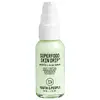What's inside
What's inside
 Key Ingredients
Key Ingredients

 Benefits
Benefits

 Concerns
Concerns

No concerns
 Ingredients Side-by-side
Ingredients Side-by-side

Water
Skin ConditioningGlycerin
HumectantNiacinamide
SmoothingIsopropyl Lauroyl Sarcosinate
Skin ConditioningPropanediol
SolventTriethyl Citrate
MaskingBrassica Oleracea Acephala Leaf Extract
HumectantCamellia Sinensis Leaf Extract
AntimicrobialChamomilla Recutita Flower Extract
MaskingMedicago Sativa Extract
TonicSpinacia Oleracea
Skin ConditioningAdenosine
Skin ConditioningAlteromonas Ferment Extract
Skin ConditioningAscorbyl Glucoside
AntioxidantBisabolol
MaskingCapryloyl Salicylic Acid
ExfoliatingCarnosine
Skin ConditioningHydroxypalmitoyl Sphinganine
Skin ConditioningPentaerythrityl Tetra-Di-T-Butyl Hydroxyhydrocinnamate
AntioxidantSodium Hyaluronate
HumectantSodium Hydroxide
BufferingTaraxacum Officinale Rhizome/Root Extract
Skin ConditioningTrisodium Ethylenediamine Disuccinate
Tocopherol
AntioxidantBrassica Oleracea Italica Seed Oil
EmollientCeramide NP
Skin ConditioningBoron Nitride
AbsorbentDipotassium Glycyrrhizate
HumectantAmmonium Acryloyldimethyltaurate/Vp Copolymer
Butylene Glycol
HumectantCetearyl Alcohol
EmollientCetearyl Glucoside
EmulsifyingCI 77891
Cosmetic ColorantEthylhexyl Palmitate
EmollientGlucomannan
Skin ConditioningGlyceryl Stearate
EmollientPEG-100 Stearate
Pentylene Glycol
Skin ConditioningSynthetic Fluorphlogopite
Tin Oxide
AbrasiveTrihydroxystearin
Skin ConditioningXanthan Gum
EmulsifyingCI 77288
Cosmetic ColorantChlorphenesin
AntimicrobialPhenoxyethanol
PreservativeParfum
MaskingWater, Glycerin, Niacinamide, Isopropyl Lauroyl Sarcosinate, Propanediol, Triethyl Citrate, Brassica Oleracea Acephala Leaf Extract, Camellia Sinensis Leaf Extract, Chamomilla Recutita Flower Extract, Medicago Sativa Extract, Spinacia Oleracea, Adenosine, Alteromonas Ferment Extract, Ascorbyl Glucoside, Bisabolol, Capryloyl Salicylic Acid, Carnosine, Hydroxypalmitoyl Sphinganine, Pentaerythrityl Tetra-Di-T-Butyl Hydroxyhydrocinnamate, Sodium Hyaluronate, Sodium Hydroxide, Taraxacum Officinale Rhizome/Root Extract, Trisodium Ethylenediamine Disuccinate, Tocopherol, Brassica Oleracea Italica Seed Oil, Ceramide NP, Boron Nitride, Dipotassium Glycyrrhizate, Ammonium Acryloyldimethyltaurate/Vp Copolymer, Butylene Glycol, Cetearyl Alcohol, Cetearyl Glucoside, CI 77891, Ethylhexyl Palmitate, Glucomannan, Glyceryl Stearate, PEG-100 Stearate, Pentylene Glycol, Synthetic Fluorphlogopite, Tin Oxide, Trihydroxystearin, Xanthan Gum, CI 77288, Chlorphenesin, Phenoxyethanol, Parfum
Water
Skin ConditioningSaccharide Isomerate
HumectantTranexamic Acid
AstringentGlycerin
HumectantArbutin
AntioxidantGlycyrrhiza Glabra Root Extract
BleachingCalendula Officinalis Extract
Skin ConditioningPhenoxyethanol
PreservativeSodium Polyacrylate Starch
AbsorbentSparassis Crispa Extract
Emulsion StabilisingBeta-Glucan
Skin ConditioningEthylhexylglycerin
Skin ConditioningStreptococcus Thermophilus Ferment
HumectantIngredients Explained
These ingredients are found in both products.
Ingredients higher up in an ingredient list are typically present in a larger amount.
Glycerin is already naturally found in your skin. It helps moisturize and protect your skin.
A study from 2016 found glycerin to be more effective as a humectant than AHAs and hyaluronic acid.
As a humectant, it helps the skin stay hydrated by pulling moisture to your skin. The low molecular weight of glycerin allows it to pull moisture into the deeper layers of your skin.
Hydrated skin improves your skin barrier; Your skin barrier helps protect against irritants and bacteria.
Glycerin has also been found to have antimicrobial and antiviral properties. Due to these properties, glycerin is often used in wound and burn treatments.
In cosmetics, glycerin is usually derived from plants such as soybean or palm. However, it can also be sourced from animals, such as tallow or animal fat.
This ingredient is organic, colorless, odorless, and non-toxic.
Glycerin is the name for this ingredient in American English. British English uses Glycerol/Glycerine.
Learn more about GlycerinPhenoxyethanol is a preservative that has germicide, antimicrobial, and aromatic properties. Studies show that phenoxyethanol can prevent microbial growth. By itself, it has a scent that is similar to that of a rose.
It's often used in formulations along with Caprylyl Glycol to preserve the shelf life of products.
Water. It's the most common cosmetic ingredient of all. You'll usually see it at the top of ingredient lists, meaning that it makes up the largest part of the product.
So why is it so popular? Water most often acts as a solvent - this means that it helps dissolve other ingredients into the formulation.
You'll also recognize water as that liquid we all need to stay alive. If you see this, drink a glass of water. Stay hydrated!
Learn more about Water